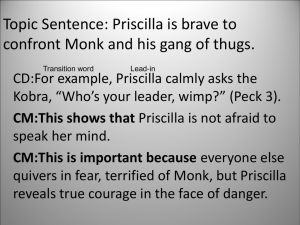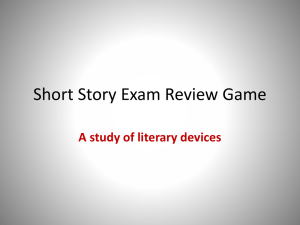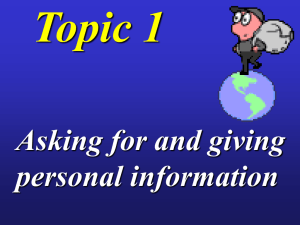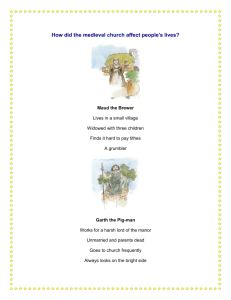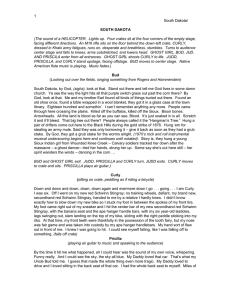Catapulting Toward Analysis & Written Response with Questions
advertisement
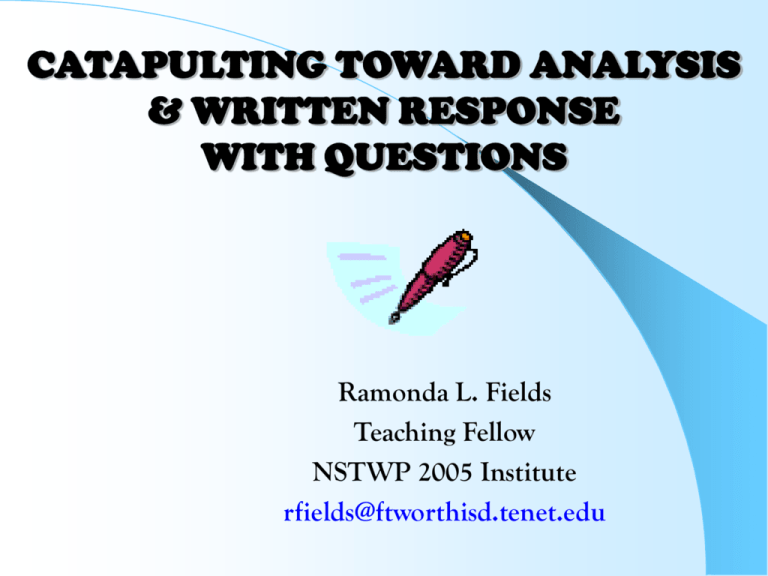
CATAPULTING TOWARD ANALYSIS & WRITTEN RESPONSE WITH QUESTIONS Ramonda L. Fields Teaching Fellow NSTWP 2005 Institute rfields@ftworthisd.tenet.edu THOUGHT TO PONDER The classic concept of learning is that it occurs when the teacher asks the questions and the learner can answer them, but reality is that learning does not occur until the learner needs to know and can formulate the question for himself (Morgan and Saxton, 75) Motivation My students had not been exposed to constant, interactive methods to go beyond the knowledge and comprehension levels of thought (ELL/LEP, Gifted and Pre-AP/AP). Philosophy of Many Educators questions and students’ responses are the main interactions in the traditional classroom, and as such they are essential to teaching and learning” (Dillon). “Teachers’ Composing the Question LEVEL 1 “Right There” Question Who is Where is What is When is How many When did What kind of What happened Composing the Question LEVEL 2 “Think and Search” Question Explain Find examples of What caused Summarize Compare/Contrast How did Why did Theme/Life Lesson Composing the Question LEVEL 3 “Author and Me” or “On My Own” Question Predict/Infer What might have happened if Propose an alternative How might you prove State a rule Which is more moral Justify the actions of Level 1 Questions Match Bloom’s Taxonomy Knowledge & Comprehension Levels Level 2 Questions Match Bloom’s Application & Analysis Levels Level 3 Questions Match Bloom’s Synthesis & Evaluation Levels Taking Action “Questions are powerful tools for facilitating thinking about significant knowledge. They should also convey to students the potential of questioning for their learning” (Sattes and Walsh, 36) Level 1 Questions -- Student Samples Who were the Kobras? -- “Priscilla & the Wimps” What kind of expectations did Sandra Cisneros’ father have for her opposed to the expectations he had for his sons? -- “Only Daughter” What is the “black table”? -- “The Black Table is Still There” What is the purpose of Staples using the word “victim” in the first sentence? – “Just Walk On By” Level 2 Questions -- Student Samples Explain what caused Priscilla to take such action against Monk. - - “Priscilla and the Wimps” Summarize the attitude of the teacher toward Richard’s situation. - - “Shame” Explain and compare how the all black table is parallel to self segregation in society. - - “The Black Table is Still There” Summarize the events that forced Staples to change the way he walked in public. - - “Just Walk On By” Level 3 Questions -- Student Samples Predict what kind of person Monk Klutter turned out to be after the incident with Priscilla. – “Priscilla and the Wimps” Justify Graham’s reaction toward integration. What would you have done if you were placed in the author’s situation? -- “The Black Table is Still There” Justify Staples’ use of onomatopoeia in paragraph three. – “Just Walk On By” What can you infer about Richard’s lifestyle after he was humiliated by the teacher? – “Shame” Benefits of Inquiry-Driven Classroom The Youth Learn Initiative observes, “Many kids who have trouble in school because they do not respond well to lectures and memorization will blossom in an inquiry-based learning setting, awakening their confidence, interest, and self-esteem.” (2001) Responsive Strategy A nswer the Question P rovide “Textual Evidence” E xplain With Independent Thought A nswer the Question -- Clear, specific response; be sure to actually answer -- Should be evident what question is -- Include names, places or important terms from question P rovide “Textual Evidence” -- Should support or highlight response as credible -- Should easily connect to response with relevance E xplain With Independent Thought -- Should illustrate an individual connection to question/text -- Should convey some individual analysis -- Should express what you learned or how you reacted to question/text BEGINNING RESPONSE Why would the ending of the story be categorized as ironic? He thinks that he is white even though he is black. “Desiree’s Baby” – representative of most responses BEGINNING RESPONSE How do the passengers’ reactions differ according to their gender? The reactions between the males and females had differences because of the ways they had acted on the situation dealing with Samuel. The males had stated “these kids do seem to be acting sort of stupid” but they thought of some of the brave things they had done when boys and women became very angry when they saw the four boys. “Samuel” EVENTUAL RESPONSE Why did the author use rhetorical questions to emphasize his attitude throughout the passage? Lawrence Graham used rhetorical questions like, “Why did the black kids separate themselves?” to show his agitation toward the situation. He reacted to those students putting a thin wall between themselves and all other kids in the school. He was frustrated with the selfseparation that had occurred for years. “The Black Table Is Still There” EVENTUAL RESPONSE Contrast how Monk Clutter is presented at the beginning and end of “Priscilla and the Wimps”. At the beginning of “Priscilla and the Wimps”, Monk is presented as a very big and powerful “ruler”. However, toward the end, Priscilla changes that because of her view of him, and transforms him into the victim. When Priscilla meets face to face with Monk, Monk says, “Who is it around here that doesn’t know Monk Klutter?” and Priscilla responds, “Never heard of him.” She had no fear of him whatsoever, becoming the “ruler” of a new “wimp”. “Priscilla and the Wimps” EVENTUAL RESPONSE How does the subway car depicted in this story act as a microcosm of society? Society is represented in two angles with the people on the subway car. The passivists and activists are primarily represented by two main characters. The woman who gains the courage to speak up fails to follow through with action. The man who enforces her words “. . . where he pulled the emergency cord” reacts too late, and in his actions ultimately causes Samuel’s death. Responsibility is being refused, causing a deterioration of society. “Samuel” Connections All grade levels benefit from Level Questions. EX: “What might have happened if Little Red Riding Hood arrived at Grandma’s before the wolf?” “Explain why it is moral/right for Robin Hood to rob the rich and give to the poor.” “What might have happened if Matilda had been honest about the necklace?” Dealing with question types for SAT, AP, formal assessments TEKS Alignment (1) Writing Purposes (c) organize ideas to ensure coherence, logical progression and support for ideas (7) Reading/Comprehension (b) draw upon his/her own background to provide connection to texts (c) draw inferences: conclusions, generalizations, predictions and support with text evidence and experience (10) Reading/Literary Response (b) use elements of text to defend his/her own responses and interpretations (12) Reading/Comprehension (c) reads critically to evaluate writer’s motives and purpose TAKS Alignment Short Answer Items/OEQ The short answer items on each test assess two skills. Students must be able to generate clear, reasonable, thoughtful ideas or analyses about some aspect of the published literary and expository selections. Students must be able to support the analyses with relevant, strongly connected textual evidence. Final Thought By using higher order thinking or reasoning skills students do not remember only factual knowledge. Instead, they use their knowledge to problem solve, to analyze, and to evaluate. (Brualdi) Bibliography Blanchette, Judith (2001). “Questions in the Online Learning Environment”. Journal of Distance Education. Brualdi, Amy C (1998). “Classroom Questions”. Practical Assessment, Research and Evaluation. pp.1-3 Morgan, Norah and Juliana Saxton (1994). Asking Better Questions. Markham, Ontario: Pembroke. Raphael, T.E. (1986). “Teaching Question Answer Relationships”. The Reading Teacher. p.512. Sattes, Beth D. and Jackie Walsh (2003). Questioning and Understanding to Improve Learning and Thinking. Charleston, WV: AEL Publishing. Youth Learn Initiative (2001) “Introduction to Inquiry Based Learning”. Morino Institute.
